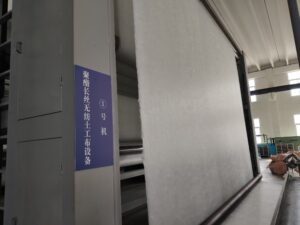What is geotextile?
Geotextile is a synthetic textile material specifically designed for use in civil engineering and construction projects to improve soil stability, drainage, filtration, and erosion control. It is commonly used in geotechnical and environmental applications. Geotextiles are made from synthetic polymers such as polypropylene or polyester, and they come in various forms, including woven and non-woven fabrics.
The primary functions of geotextiles include:
Separation: Geotextiles are placed between different soil layers or between soil and other materials to prevent mixing. This helps in maintaining the integrity of each layer and prevents the loss of fine particles into coarser materials.
Filtration: Geotextiles act as filters by allowing water to pass through while preventing the movement of soil particles. This is particularly useful in drainage applications, where geotextiles help prevent clogging of drainage systems.
Drainage: In some cases, geotextiles are used to enhance drainage by allowing water to flow through the fabric while preventing the movement of soil particles. This is beneficial in areas prone to waterlogging.
Erosion Control: Geotextiles can be used to stabilize soil and prevent erosion in areas where there is a risk of soil displacement due to water flow or wind.
Reinforcement: Geotextiles can be used to reinforce soil structures, such as retaining walls and embankments, by providing additional tensile strength.
Protection: Geotextiles can be employed to protect geomembranes or other materials from punctures or damage caused by sharp objects or rough surfaces.
The specific type of geotextile chosen for a particular application depends on factors such as the project requirements, soil characteristics, and environmental conditions. Geotextiles have become an essential component in many civil engineering and construction projects for their ability to enhance the performance and longevity of various structures and systems.

Geotextiles come in different types, and their classification is based on factors such as manufacturing method, material composition, and intended application. The main types of geotextiles include:
Woven Geotextiles:
These are manufactured by weaving individual yarns together, forming a fabric with measurable strength and load-carrying capacity.
Woven geotextiles are commonly used for applications where strength and filtration are crucial, such as in road construction and soil stabilization.
Non-Woven Geotextiles:
Non-woven geotextiles are produced by bonding or needle-punching fibers together without the need for weaving.
They are often used for applications requiring filtration, drainage, and separation, and are more commonly used in areas where strength is not the primary consideration.
Knitted Geotextiles:
Knitted geotextiles are produced by interlocking loops of yarn, creating a fabric with good tensile strength and flexibility.
They are often used in applications where flexibility and conformity to irregular surfaces are important, such as in embankment protection.
Hybrid Geotextiles:
Hybrid geotextiles combine different materials or construction methods to achieve specific performance characteristics.
For example, a hybrid geotextile might combine the strength of woven fabric with the filtration properties of non-woven material.
Silt Fence Fabric:
Silt fence fabric is a type of geotextile designed specifically for erosion control and sediment retention. It is commonly used in construction sites to prevent soil runoff and sedimentation in water bodies.
Geogrids:
While not strictly geotextiles, geogrids are often included in discussions about geosynthetics. Geogrids are used for soil reinforcement and stabilization, providing strength through their grid-like structure.
Geomembranes:
Geomembranes are thin sheets of synthetic material used for containment applications, such as lining ponds, landfills, and other structures. While not a geotextile, they are often used in conjunction with geotextiles for various applications.
The selection of the appropriate geotextile type depends on the specific requirements of the project, including factors like soil conditions, drainage needs, and the desired level of reinforcement or separation. Different geotextile types offer varying combinations of properties to meet the diverse needs of civil engineering and construction projects.


